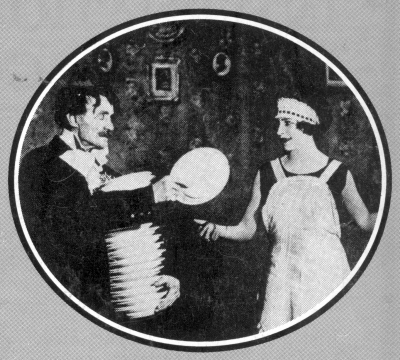 |
Page 38 Spring 1989
|
ALL OUR YESTERDAYS Reprinted with permission from "4,000 Years of Juggling, Vol. 1" by Karl-Heinz Ziethen
The
variety theatre has seen funny jugglers
in large numbers since i~. early days. But the master of this type of
comic was the Dane Carl Baggessen, in whose hands tons of porcelain
broke.
Baggessen
rose to stardom during the 1890's. Originally he worked as a
contortionist in variety theatres and was also known as "Klischnigg"
amongst the artiste!l in Germany. In America the artiste had the idea
to use his comedic talents in his act and within a few years the
clumsy juggler became a star.
His
act opened with a young maid wearing a white apron and juggling three
oranges. This was nothing special, but when Carl Baggessen stepped
from the background in his old, much-too-big morning suit, he aroused
interest.
Baggessen
came to the front of the stage to let the audience admire him. He
liked the morning suit, the gloves and the white tie so much that it
didn't occur to him to do anything. He just stood there, putting one
foot in front of the other and sighing with deep relief. The maid, who
was his wife, Saphira: stood in the
background and juggled with the three oranges.
Baggessen
dido't even look, but she
And
this is how Baggessen's bad luck started. He was terribly startled
when the plate smashed and he grabbed onto a sideboard. He shouldn't
have done this because the sideboard was covered with sticky
fly-paper, which was now sticking to his nice white gloves. Baggessen
peeled himself off the sideboard and went to help the maid by handing
her the plates and even juggled himself. Naturally everything went
wrong. Plates,
crockery and flower pots were all smashed until finally he was wading
through a rubble of porcelain. But the size of the heap was not the
main object. None was broken without a motive, without a reason or a
point. Rather than a bull in a china shop, Baggessen was a poet in a
china shop.
Baggessen tried to ensure his success with cautious, gentle movements. He saved one plate but smashed ten others in the process. He meant to catch an orange and
a plate. He caught the orange, fishing it out of the air with both
hands, proud and pleased as Punch. But the plate fell to the floor and
broke. .
Finally
the last pile of plates was leaning like a snake against his body,
ready to smash. The pile wobbled but Baggessen regained the balance.
He finally fell with them, but managed to keep one in his hand. He
held it up triumphantly in the air and stood there happy and proud. He
trembled from excitement, holding the lone survivor carefully in both
hands. But even this last plate, his only trophy of the gruesome fight
with the porcelain, slipped and from his hands and fell. He stood in
this chaos, amongst the debris of porcelain, ashamed and resigned,
timid and shy, ignorant of the world and dreamy.
After almost three decades of performing, he appeared before them for the last time at the Wintergarden Berlin in February 1927. He retired to his manor, Carlshaab, on the Danish Island of Thuro and died there at age 68 on May 21, 1931. |
 |